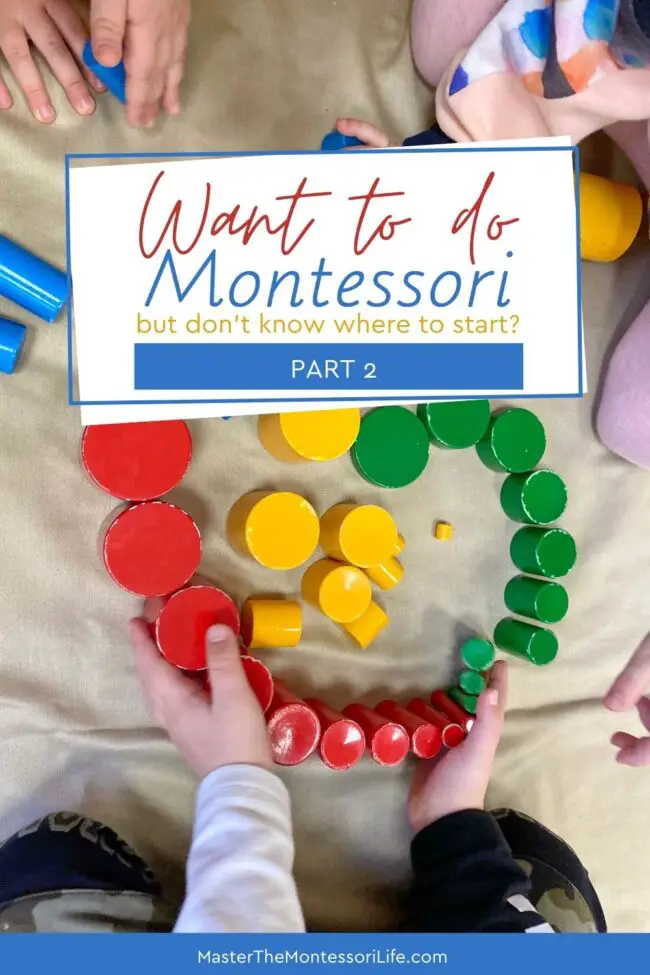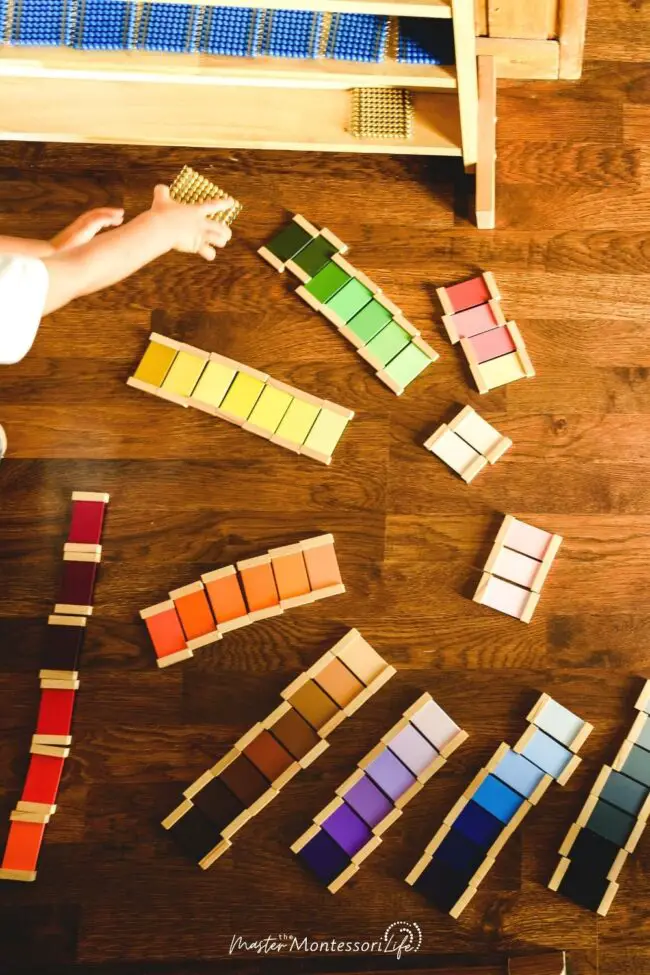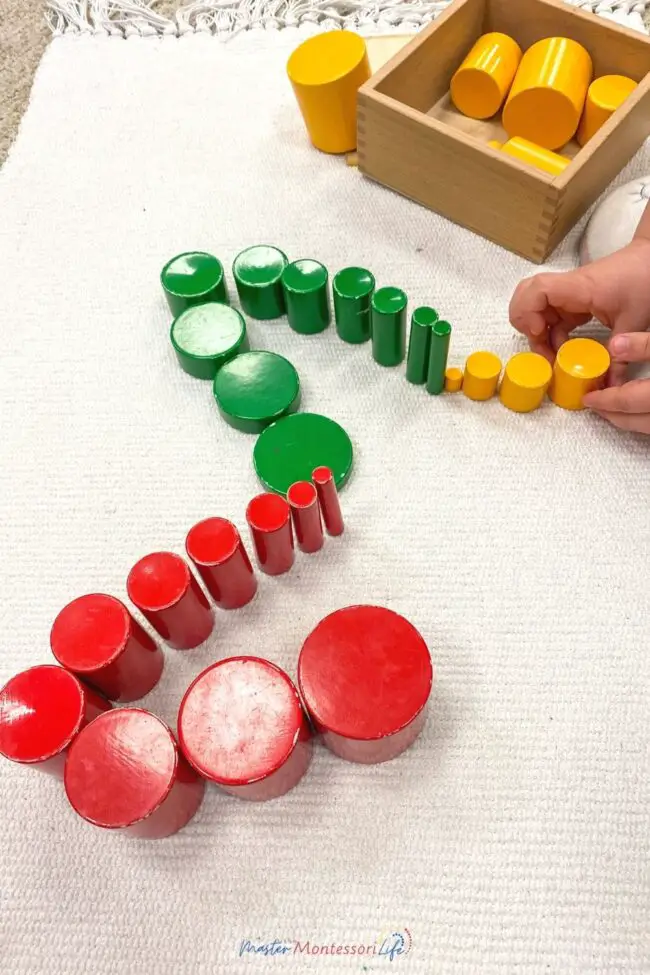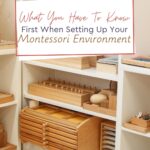Welcome to Part 2 of the series “Want to do Montessori, but don’t know where to start?”
It’s just the beginning of your amazing and detailed journey following Dr. Maria Montessori’s method.
This is all I can do to help you so far, so far, but I will continue to help you ease your way as far as possible.
All right, let’s get going to learn more about Montessori education!
Whether you send your child to a Montessori school or you are want ing to do Montessori at home, this is a great series for you!
This is a series of 5 parts and in it, you will learn what you need to know to get started! Be sure to read all 5 parts!
But in case you missed Part 1, please go HERE to read it and then come read the next logical steps to take.

3 Decide how much you are going to do Montessori
A large number of families desire to integrate Montessori into their daily life in as many aspects as possible.
This is what many call “The Montessori Lifestyle.”
And of this, the whole-hearted nature of which they see it as, they incorporate this educational program into their daily activities, not just their learning environments (Montessori classrooms).
Young children develop in basically two phases in life:
- The early phase in which they have Montessori ideals applied to them
- The late phase in which they are “normalized”
Other families incorporate it into their everyday schedule of things to do, but not as much as possible.
They prefer to follow Montessori as an educational approach in academics only.
Although their library space contains many Montessori textbooks, these students only use the Montessori method when it comes to academic subject areas.
Yes, there is such a group that will only focus on the academic side of Montessori.
And yet another group will only focus on the lifestyle side of Montessori and not pay as much attention (or give no attention at all) to the academic side of Montessori.
Don’t be shocked about this.
Yes, there is a whole lot more than academics in The Montessori Method.
If you didn’t know this, then it’s a sign that you do have a lot to learn about it.
That’s ok. You’re here, so you’re in the right place.
No matter which way you want to go, you’re neither right nor wrong.
You can choose to do whatever suits you and your family.
It is very common for people to start out with one method and then use other approaches when they find that it doesn’t have enough results.
I spent so much time researching children’s growth stages when we tried to start Montessori (First Stage being Practical Life and Sensorial).
Before my child was two years old, we started using Montessori tools for topics that were simple and ones he was able to follow with me presenting the lessons the Montessori way.
This stage can assist you in figuring out what you may be most valuable to you.

4 Minimize and Rotate Montessori Toys and Montessori Materials
Let’s be honest for a minute.
You, as The Montessori teacher, know that you need to be smart about the things that you are presenting to the child, whether it is for work or for play.
You need a strategy. You need a high quality plan.
Let me help you get organized and have a well-done chart that will make all the difference for you and the child.
If a baby is between 1 and 12 months of age, you can get the number of toys (made of natural materials) on the shelf to be equal to the number of months that they are.
For instance, if your baby is 6 months old, you can only provide him or her with six (preferably, wooden) toys.
Once the child is older than 12 months, you can stick with 12 toys or works for a time until you feel that the child is mature enough to handle more.
But how can you make it successful and doable?

Well, for one, you need consistency. Have a plan.
Take a look at the chart in the next page to gauge an example of how you can plan your rotation of toys and works.
The page after that, you will get your own blank chart for you to fill out yourself.
Make copies as needed.
This is a wonderful way to extend the use and life of the material, but still managing to squeeze in cleanliness and order.
The older the child is, the more they will decide on what they want to work with (on an unrolled flood mat or on a child-sized table).
The more they get to practice this, the more they can learn about how to get the tray with the work and return the learning materials back to the shelf correctly.
In Conclusion for Part 2
Alright! We have gotten through four very important points so far.
I know that you have found them helpful and that surely made you think.
But there are more!
Head over to Part 3.
- Teach Children the Flags of the World the Montessori Way
 Geography is one of many children’s favorite subjects. One of the reasons why is because country flags are so cool and very unique. Come and find out how you can teach children about some of the flags of the world.
Geography is one of many children’s favorite subjects. One of the reasons why is because country flags are so cool and very unique. Come and find out how you can teach children about some of the flags of the world. - Understanding the Montessori Curriculum for Preschoolers
 What exactly makes the Montessori preschool curriculum stand out? Let’s find out here!
What exactly makes the Montessori preschool curriculum stand out? Let’s find out here! - 3 Winter-Themed Fine Motor Skills Hands-on Activities
 Today, I am going to show you three winter-themed fine motor skills hands-on activities for children to make with you or by themselves.
Today, I am going to show you three winter-themed fine motor skills hands-on activities for children to make with you or by themselves. - Introduce Hibernation, Migration and Adaptation to Children
 When you introduce your children to the concepts of hibernation, migration and adaptation, you will love to learn how they find food, which ones follow each of these survival techniques and so much more.
When you introduce your children to the concepts of hibernation, migration and adaptation, you will love to learn how they find food, which ones follow each of these survival techniques and so much more. - Know this first when setting up your Montessori environment
 If you have been wondering how to move forward in setting up your Montessori environment, but don’t know how to do it right, then come watch this training!
If you have been wondering how to move forward in setting up your Montessori environment, but don’t know how to do it right, then come watch this training! - Printable Montessori Holiday Gift Guide
 I’ve made it very simple for you to get your hands on these fantastic ideas for Montessori education!
I’ve made it very simple for you to get your hands on these fantastic ideas for Montessori education!



